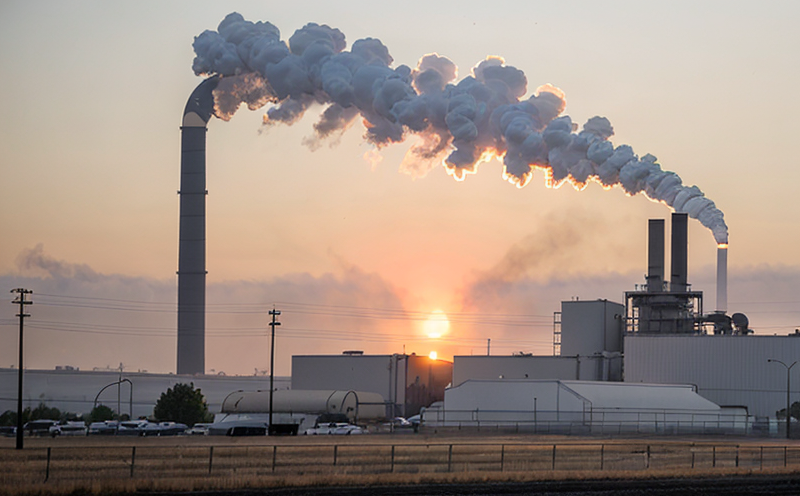ASTM D6522 CO CO₂ NOx Testing in Combustion Emissions
The ASTM D6522 test method is a critical standard for determining the concentrations of carbon monoxide (CO), carbon dioxide (CO₂), and nitrogen oxides (NOₓ) in combustion emissions. This testing service is essential for ensuring compliance with local, national, and international emission regulations across various industrial sectors including energy production, manufacturing, and transportation.
Industries reliant on combustion processes often face stringent environmental regulations aimed at reducing air pollution. The ASTM D6522 test method provides a standardized approach to monitor these emissions accurately, thereby enabling industries to meet regulatory requirements while optimizing their operational efficiency. This service is particularly valuable for facilities using fossil fuels in boilers, furnaces, and engines.
The testing process involves the collection of emissions samples at specific points within the combustion system. These samples are then analyzed using advanced analytical instruments capable of detecting trace levels of CO, CO₂, and NOₓ. The precision and reliability of these instruments ensure that even minute fluctuations in emission levels can be accurately measured.
Understanding the significance of each pollutant is crucial for effective management:
- CO: A toxic gas produced when carbon-based fuels are not burned completely. Monitoring CO helps identify incomplete combustion issues, which can lead to increased emissions and potential safety hazards.
- CO₂: A greenhouse gas that contributes significantly to global warming. Accurate measurement of CO₂ is vital for assessing the environmental impact of industrial processes.
- NOₓ: Oxides of nitrogen that are major precursors to smog and acid rain. Controlling NOₓ emissions is a key component in reducing air pollution.
The ASTM D6522 test method provides a comprehensive approach to emission control by offering quantifiable data on these pollutants. This information can be used to fine-tune combustion processes, improve fuel efficiency, and enhance overall environmental compliance. The service also includes detailed reports that outline the results of each analysis, providing actionable insights for process optimization.
In addition to its role in regulatory compliance, ASTM D6522 testing supports continuous improvement initiatives by offering real-time data on emission performance. This allows facilities to identify trends and address issues proactively, ensuring long-term sustainability and operational excellence.
Scope and Methodology
| Parameter | Methodology |
|---|---|
| Carbon Monoxide (CO) | Determination of CO is achieved using a gas chromatograph equipped with a thermal conductivity detector. |
| Carbon Dioxide (CO₂) | Quantification of CO₂ is performed via an infrared gas analyzer, which measures the absorption of infrared light by CO₂ molecules in the sample gas stream. |
| Nitrogen Oxides (NOₓ) | The measurement of NOₓ involves a chemiluminescence detector that converts NOₓ into nitric oxide and then measures the luminescent signals produced during this conversion. |
The testing process begins with sample collection at strategic locations within the combustion system. These samples are carefully preserved to maintain their integrity until analysis. The selected instruments for each parameter ensure high accuracy, repeatability, and precision in measurement.
Once collected, the samples undergo rigorous preprocessing steps including cleaning, conditioning, and dilution if necessary. This ensures that the sample is suitable for accurate analysis by the specific instrument used for each pollutant.
The results generated from these tests are then compared against established standards and guidelines such as ISO 14067, ASTM D6522, and local regulatory requirements. These comparisons provide a clear picture of compliance status and identify areas requiring improvement or adjustment.
Quality and Reliability Assurance
At our laboratory, we prioritize quality and reliability in every aspect of ASTM D6522 CO CO₂ NOₓ testing. Our team of highly skilled chemists and engineers ensures that each test adheres strictly to the ASTM standards and local regulations. This commitment is reflected in our state-of-the-art facilities equipped with cutting-edge analytical instruments.
We employ rigorous quality control measures throughout the testing process, from sample collection to final reporting. These measures include regular calibration of all analytical equipment, strict adherence to standard operating procedures (SOPs), and comprehensive documentation of each test run. Our proficiency in ASTM D6522 ensures that our results are consistently accurate and reliable.
In addition to internal quality control checks, we also participate in external proficiency testing programs where our laboratory's performance is evaluated against industry benchmarks. This continuous assessment helps us maintain the highest standards of accuracy and precision.
Our dedicated team of experts works closely with clients to interpret test results and provide actionable recommendations for process optimization. By leveraging our expertise and advanced technology, we ensure that each client receives comprehensive support tailored to their specific needs.
Environmental and Sustainability Contributions
The ASTM D6522 CO CO₂ NOₓ testing service plays a pivotal role in promoting environmental sustainability. By accurately measuring emissions of key pollutants, this service enables industries to make informed decisions that reduce their environmental footprint.
Emissions reductions achieved through optimized combustion processes can lead to significant decreases in greenhouse gas emissions and air pollution. This not only helps facilities comply with regulatory requirements but also contributes positively to the global effort against climate change.
In addition to direct emission reductions, the service supports broader sustainability goals by fostering innovation within industrial operations. By identifying areas where improvements are needed, this testing can drive the development of more efficient and environmentally friendly technologies and practices.
Our commitment to environmental responsibility extends beyond individual tests. We actively participate in industry initiatives aimed at advancing sustainable manufacturing processes and promoting best practices for emissions management. Through our expertise and dedication, we contribute to a cleaner, healthier environment for all.





